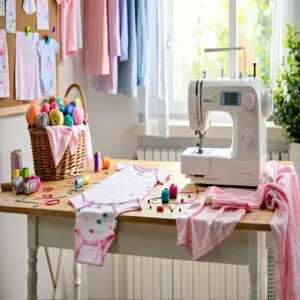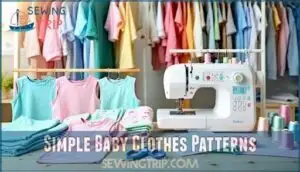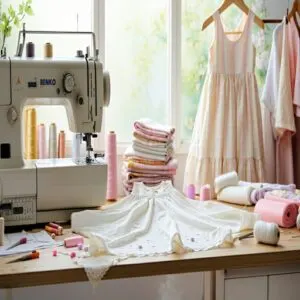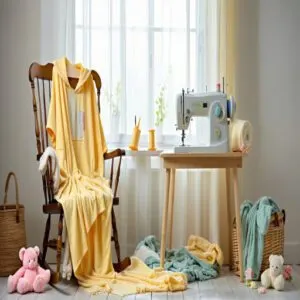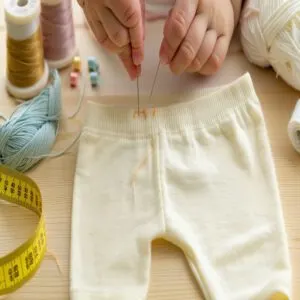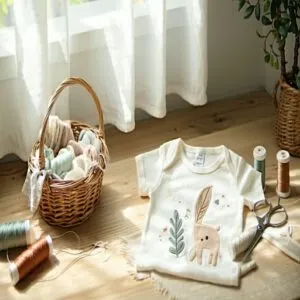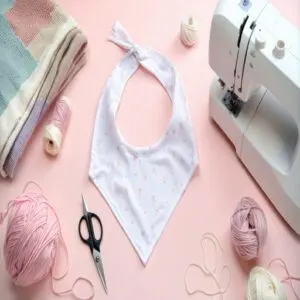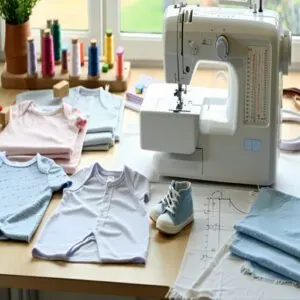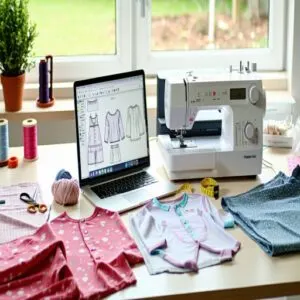This site is supported by our readers. We may earn a commission, at no cost to you, if you purchase through links.
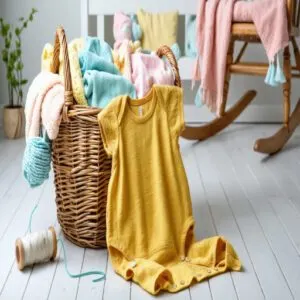
These projects skip tricky closures and focus on stretchy fabrics, like knit or bamboo, which are soft and forgiving—perfect for growing little ones.
A quick romper with snaps or a cozy baby blanket can also be fun and practical for beginners.
Remember to pre-wash your fabric to avoid post-sewing shrinkage, and don’t overthink it—babies make anything adorable, so keep it simple with stretchy fabrics and soon you’ll be stitching your way to wardrobe staples with simple sewing patterns.
Ready to explore dress patterns or onesies next? Stay tuned!
Table Of Contents
Key Takeaways
- Prewash your fabric to prevent shrinkage and ensure it’s soft for baby’s sensitive skin.
- Start with easy projects like elastic-waist pants, bibs, or blankets to build confidence.
- Use soft, stretchy fabrics like knit or bamboo for comfort and durability.
- Stick to basic tools like a sewing machine, sharp scissors, and fabric rulers to simplify the process.
Sewing Baby Clothes Basics
When you’re sewing baby clothes, start with the right tools, like sharp scissors and a sewing machine, to make the process smooth.
Choose soft, durable fabrics and simple patterns that let you focus on creating something both practical and adorable.
Essential Sewing Tools
Got the urge to try DIY baby clothes patterns? Start with these must-have tools:
- Sewing Machine – Any basic machine works for small projects.
- Measuring Tools – A fabric ruler or measuring tape guarantees precision.
- Fabric Cutters – Sharp scissors or rotary cutters make clean cuts.
- Thread Types & Sewing Needles – Match these to the fabric for sturdy stitching!
Understanding baby clothes sewing patterns is vital for a successful DIY project.
Choosing Fabric
Now that you’ve got your tools ready, let’s explore the perfect fabric for your baby’s clothes.
Soft, breathable materials make all the difference for sensitive skin.
When choosing fabrics, consider visiting resources for free sewing patterns to guarantee the best results.
| Fabric Type | Best For | Durability | Care | Safety |
|---|---|---|---|---|
| Bamboo | Everyday | High | Easy | Excellent |
| Woven Cotton | Summer | Medium | Simple | Very Good |
| Knit Fabrics | Stretchy Items | High | Moderate | Good |
| French Terry | Winter Wear | High | Easy | Good |
| Double-Brushed Polyester | Avoid | Low | Hard | Poor |
Pre-wash your fabric before sewing – it’s a game-changer for preventing shrinkage surprises later.
Understanding Patterns
Reading baby clothes sewing patterns is like following a roadmap to style.
You’ll find basic markings that guide your journey: cutting lines show where to trim, notches help pieces match up, and grain lines point to fabric direction.
Pattern guides explain essential sewing terms and measurement tips clearly.
Most easy baby clothes patterns include size adjustments, perfect for growing little ones.
Simple Baby Clothes Patterns
Now that you’ve got your tools ready, let’s start with some simple baby sewing projects that won’t make you sweat.
These easy baby clothes patterns are perfect for beginners who want to create adorable baby apparel.
Here are five popular starter projects that’ll build your confidence:
- Basic baby bib pattern – a fan favorite for new sewists
- Simple elastic-waist pants – no complicated closures needed
- Quick romper suit – customizable with optional ruffles
- Cozy baby blanket – perfect for practicing straight stitches
- Basic baby leggings – stretchy and forgiving to sew
You’ll find these baby clothes patterns free online, complete with step-by-step instructions.
For more information on getting started with baby sewing patterns, consider exploring various resources that can guide you through the sewing process.
DIY Baby Dress Patterns
You’ll find making baby dresses at home isn’t as hard as you might think, with patterns ranging from simple sleeveless designs to lined bodice styles that fit newborns to 24-month-olds.
Whether you’re creating a casual summer dress or a special occasion outfit, you’ll need just basic sewing skills and about two yards of soft cotton fabric to get started.
Easy Baby Girl Dresses
While you’re just starting with baby girl dresses, begin with a simple gathered-tier dress that works perfectly for newborns to 3-month-olds.
These baby dress patterns need only basic straight stitches and light cotton fabric for comfort.
Your first dress sewing project can include sweet details like a matching headband or booties.
Free templates in multiple sizes make the process beginner-friendly.
Versatile Baby Dresses
Several versatile baby dress patterns from the latest clothing trends adapt beautifully as your little one grows.
These handmade baby clothes patterns feature smart design elements like raglan sleeves and adjustable waistbands that work through multiple stages.
Digital patterns make it easy to create these adaptable pieces right at home.
- Criss-cross necklines that make dressing wiggly babies a breeze
- Tiered skirt designs that grow with your baby’s first steps
- Kimono-style bands that adjust for comfort
- Gathered peplum styles that evolve from crawling to walking
- Convertible designs that work as both dresses and tunics
Special Occasion Dresses
When your little one needs to shine, special occasion dresses make memories sparkle.
The Orchidée Dress, with its deep V-neck and bridal buttons, offers a beautiful holiday dress option.
From christening wear like the Two Pillowcase Gown to formal baby pageant styles, you’ll find perfectly sized patterns from newborn to 24 months.
Baby party dresses shine with lined bodices and coordinating accessories, making them a great choice for any holiday dress option.
Baby Tops and Bottoms
You’ll love making these comfortable baby tops and bottoms that fit perfectly from newborn to 24 months, with simple step-by-step instructions for classic pieces like t-shirts, leggings, and onesies.
Whether you’re stitching a cozy sweatshirt or elastic-waist pants, you’ll find these beginner-friendly patterns use just 1-2 yards of soft cotton fabric and basic sewing techniques you already know.
DIY Baby Tops
Making baby tops is easier than you might think.
The Ringer T-shirt pattern offers both long and short-sleeve options for newborns up to 6-year-olds.
You’ll find free patterns for infant shirts, toddler tunics, and baby sweatshirts online.
Start with a simple summer tunic for 12-18 months, then progress to more complex projects like kids’ hoodies.
Cotton fabric works best for these DIY baby clothes patterns.
Hand-Sewn Baby Leggings
Soft knit fabric transforms into cozy baby leggings with just a yard of material.
You’ll cherish how quickly these simple baby sewing projects come together.
Just fold your fabric, align the pattern with the selvage, and cut mirror-image pieces.
These versatile legging styles work perfectly for your growing little one.
- Choose stretchy knit fabric or repurpose an old t-shirt for eco-friendly baby clothes patterns
- Match thread color and use a gentle straight stitch to prevent fabric stretching
- Pin front and back curves carefully before sewing your baby pants pattern
- Keep fabric flat near the machine while stitching the side seams
- For perfect fit, select from sizes preemie to toddler in most infant sewing patterns
Baby Onesies
Transform your organic cotton into charming baby onesies with 2025’s trendiest designs, featuring boho-inspired patterns like feathers and woodland themes, to create adorable tees perfect for your little one.
Create custom infant wear using just one yard of cotton for two onesies, taking advantage of the latest baby clothes patterns that feature roomy designs and breathable fabrics, making these simple baby sewing projects both practical and precious.
When choosing materials, consider the importance of softest fabric for your baby’s sensitive skin, ensuring the best comfort and care for your infant.
Baby Accessories Patterns
You’ll love creating adorable accessories for your little one with these beginner-friendly patterns for bibs, hats, and blankets that use just 1/2 to 1 yard of fabric each.
Whether you’re making a simple bandana bib or a cozy double-sided blanket, these quick projects will help you build your sewing skills.
While crafting practical items your baby will use every day, these projects will enhance your sewing experience, making it a fun and rewarding activity.
Bibs and Burp Cloths
These baby feeding accessories are quick weekend projects you’ll love making.
For a basic baby bib sewing pattern, you’ll need just 4×4-inch fabric squares and flannel backing.
Burp cloth materials work best with terry cloth or absorbent cotton – grab 1/2 yard of each.
Create unique drool pad options by mixing fun prints with practical fabrics, perfect for catching those unexpected mealtime adventures.
Using Baby Bib Patterns can help you design adorable and functional baby accessories with ease.
Hats and Headbands
You’ll love creating adorable homemade baby clothes like seamless knotted baby hats and stylish headbands.
The latest baby hat sewing patterns work beautifully with interlock or jersey knit fabrics.
Try the popular double top knot design that comes in sizes from newborn to 12 months.
For a quick project, whip up some cotton beanies or summer caps using baby-friendly stretchy knits with at least 5% Lycra.
Baby Blankets
While you’re exploring baby accessories, let’s wrap your little one in comfort.
Free sewing patterns for baby blankets offer endless possibilities, from quick 10-minute swaddle blankets to cozy textures in various blanket sizes.
Choose soft fabrics like cotton for breathability or flannel for warmth.
You’ll find simple DIY baby quilts perfect for beginners, with self-binding patterns that create professional-looking edges in two coordinating fabrics.
To create the coziest blanket, consider learning about sewing a baby blanket techniques for the best results, and enjoy making your little one a cozy textures blanket.
Benefits of Making Baby Clothes
Making baby clothes lets you create personalized pieces that fit your little one perfectly while saving money. You’ll enjoy crafting unique designs that are thoughtful, practical, and one-of-a-kind.
Personalized Gifts
Babies outgrow clothes fast, but handmade items stick around as treasured keepsakes.
Your DIY baby clothes become Baby Love Tokens when you add touches like:
- Custom Embroidery with names or dates.
- Thoughtful Gift Wrapping Ideas like fabric swaddles.
- Sweet Handmade Cards featuring your stitching story.
- Special Messages sewn inside.
Free baby sewing patterns for beginners make these gifts unforgettable!
Cost-Effective
Sewing baby clothes saves your wallet and adds a personal touch.
Budget friendly sewing doesn’t mean sacrificing style—opt for affordable fabrics and cheap patterns to create charming outfits.
Frugal crafting with free patterns simplifies DIY baby clothes.
Pairing economical designs with easy sewing patterns guarantees success for beginners while controlling costs.
Check out the comparison table below:
| Item | Store Price | DIY Cost | Savings | Time Required |
|---|---|---|---|---|
| Baby Onesies | $10 each | $3 each | 70% | 1 hour |
| Baby Leggings | $15 per pair | $4 per pair | 73% | 2 hours |
| Dresses | $25-30 | $7-10 | 66-72% | 3 hours |
| Hats/Headbands | $8 each | $2 each | 75% | 30 minutes |
| Bibs and Burp Cloths | $12 per set | $4 per set | 67% | 45 minutes |
Unique Designs
When you sew baby clothes, you’re creating something truly one-of-a-kind, a handmade baby dress sewing pattern can easily transform into a special keepsake or a trendy addition to Baby Fashion.
Mix your favorite prints or try tiny embroidery—it’s Fabric Art meets practicality.
Plus, with baby clothes patterns free online, dreaming up Cute Outfits is easier than ever!
Engaging in sewing activities can have numerous benefits, including experiencing the unexpected benefits of sewing, which can lead to a more fulfilling hobby.
Working With PDF Sewing Patterns
PDF sewing patterns make creating baby clothes simple by letting you print patterns at home instantly.
Just remember to set your printer to 100% scale, tape the pieces together, and you’re ready to cut and sew.
What is a PDF Pattern
PDF patterns are digital sewing guides you download, often as file formats like PDFs.
They’re perfect for baby sewing patterns beginners since they provide accurate sizes for baby clothes patterns free of hassle.
Just a quick download, print the pattern file, and you’re set, it’s like trading bulky books for scrollable pattern files—modern sewing’s a breeze!
How to Use PDF Patterns
Using PDF patterns is simple! Open the file on your device and set your printer to “100%” or “No Scaling” for accurate Pattern Scaling.
Once printed, align the pages using guidelines, tape them together, and cut out your Digital Cutting pieces.
For baby sewing patterns beginners, focus on Fabric Prep after cutting—no shortcuts when sewing patterns for comfort!
Tips for Printing Patterns
Before printing baby sewing patterns for beginners, fine-tune your printer settings.
Stick to 100% Pattern Scaling—don’t check "Scale to Fit." Adjust margins to center the design, and check Color Calibration so lines print clearly.
Always print a test page to confirm measurements.
For beginners using PDF patterns, these small tweaks guarantee your baby clothes patterns for newborns come out flawless, using baby sewing patterns and ensuring Color Calibration.
Choosing The Right Fabric
Choosing the right fabric is key to making baby clothes that are soft, breathable, and fit comfortably.
Stick to cotton or stretchy knits and always prewash to avoid shrinkage or irritating sensitive skin.
Cotton and Knit Fabrics
Picking fabric can be tricky, but cotton and knit fabrics are perfect for baby sewing patterns beginners.
Cotton is soft and breathable, while knits stretch for active little ones.
For detailed guidance, explore various cotton fabric choices.
Look for:
- Cotton Blends for softness and durability.
- Knit Textures that adapt to baby’s movements.
- Fiber Choices like organic options for newborns.
- Weave Patterns adding charm to simple designs!
Prewashing Fabric
Before you begin sewing patterns, prewash your fabric! It prevents shrinkage, checks color bleeding, and gives a chance for softness testing. Use care labels as a guide.
Washing cotton or quilting cotton? Stick to warm water.
| Step | Water Temp | Detergent Type | Fabric Type | Purpose |
|---|---|---|---|---|
| Prewash | Warm | Gentle | Cotton, Knits | Shrinkage Control |
| Check Care Labels | Varies | As Listed | Any | Cleaning Guide |
| Skip Fabric Softeners | N/A | None | Baby Fabrics | Softness Testing |
| Dry Before Sewing | Medium Heat | N/A | All | Fabric Preparation |
| Inspect Colors | Cool Wash | N/A | Prints | Bleed Prevention |
Fabric Selection Tips
Before sewing, picking the right fabric saves time and trouble later.
Here’s your fabric cheat sheet:
- Fabric types: Stick to cotton or soft knit fabric for breathability and comfort.
- Texture selection: Smooth quilting cotton feels great on baby skin.
- Color choices: Light hues hide wear better.
- Weave analysis: Choose woven fabric for structure, knit for stretch.
Frequently Asked Questions (FAQs)
Which are the easiest sewing patterns?
Start with bandana bibs or simple leggings—they’re quick and forgiving.
Onesies with snap closures might feel tricky but are beginner-friendly too.
Stretchy knotted hats are a breeze, perfect for testing your sewing chops!
How to take baby measurements for sewing?
Measure snug but not tight, use a soft tape around the chest, waist, hips, and neck.
Grab inseam and outseam lengths for pants.
Don’t forget shoulder to knee for dresses or rompers!
Who are the big 4 sewing patterns?
The “Big 4” sewing pattern companies are Simplicity, McCall’s, Butterick, and Vogue Patterns.
They’re your go-to for a wide range of stylish, beginner-friendly, and advanced designs, covering everything from classic styles to modern trends.
How to choose fabric for baby clothes?
When hunting for fabric, think “soft as a cloud.”
Opt for prewashed cotton like quilting cotton or jersey, avoiding anything scratchy.
Stick to breathable materials and double-check shrinkage by washing before you sew!
How do I adjust patterns for preemies?
Shrink the pattern by scaling it down proportionally—reduce it by 80-90% for preemies depending on birth weight.
Use soft, stretchy fabrics, and shorten lengths and widths slightly for a snug but comfortable fit.
What are tips for sewing stretchy fabrics?
Stretchy fabrics aren’t tricky if you use a ballpoint needle, stretch stitch, and avoid pulling.
Let the fabric glide naturally.
A walking foot works wonders, and prewash to skip sneaky shrinking later.
Relax—stretch happens!
Can baby clothes be sewn by hand only?
Yes, you can hand-sew baby clothes using basic techniques like running stitches or backstitches.
It takes more time, but the results can be just as adorable and heartfelt—perfect for personal or meaningful gifts.
How do I add snaps or button closures?
Picture tiny fasteners snapping perfectly into place—grab snap pliers for quick setups or sew buttonholes with precision.
When spacing snaps or buttons, measure every 2-3 inches for balance, ensuring closures resist curious baby tugs effortlessly, with a focus on balance.
What are some quick troubleshooting tips for sewing mistakes?
Messed up stitches? Rip them out gently with a seam ripper.
Fabric puckering? Check your tension settings. Uneven seams? Press as you go and measure twice.
Mistakes happen—embrace them as part of learning!
Conclusion
Think of sewing baby clothes like building with blocks—start simple, then add layers of creativity.
With these simple sewing patterns for baby clothes, you’ve got the tools to craft adorable, comfy outfits while learning the basics.
From elastic-waist pants to easy bibs, each project builds your confidence without overcomplicating things.
Once you’re comfortable, take on baby dresses or onesies for a fun challenge.
Remember, every stitch is one step closer to creating something unique and heartfelt!

